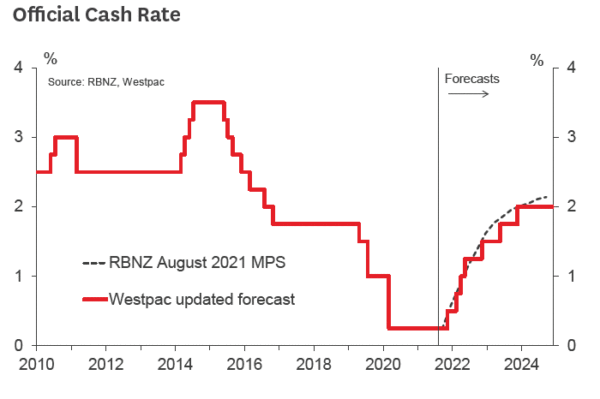- The Reserve Bank left the OCR on hold at 0.25% today, but continued to signal interest rate hikes in the future.
- The RBNZ remains on a course towards removing monetary stimulus.
- But it has had to change tack in the face of the latest Covid lockdown restrictions.
- Demand in the domestic economy has been running hot, and is now running up against capacity constraints.
- The new lockdown will undermine demand in the near term. But this can and will be addressed through fiscal policy.
- We have pencilled in an OCR hike for November. But at this early stage it’s hard to give any clear guidance as to when the RBNZ might resume its previous course.
Today’s Monetary Policy Statement was very much in line with what we expected, and indeed was a very similar take on the economy to what we detailed in our recent Economic Overview. The Reserve Bank recognises that interest rates will need to rise in the coming years, and is clearly keen to get on with the job. But circumstances have intervened, in the form of a community outbreak of Covid-19 and a return to the strictest lockdown settings.
Prior to the outbreak, we had expected three OCR hikes of 25 basis points this year, starting with today’s review. Those hikes will be deferred, rather than cancelled. However, it’s too early to give any clear guidance on when the RBNZ might return to its previously intended path. There’s a wide range of possibilities as to when and how quickly the country is able to step down the Alert Level ladder. And within that range, most (but not all) of the possibilities would probably rule out the October OCR review as too soon, so for now we’ve pencilled in the first hike for November
From there, we expect further hikes in February, April and May next year. By that time, New Zealand’s vaccination programme will be well advanced, and hopefully we will no longer be reliant on lockdowns as a Covid management tool.
Details.
Like us, the Reserve Bank has become more alert to the strength of demand in the New Zealand economy over recent months. Up until now, our Covid-free streak has allowed the economy to build up momentum to a greater degree than we’ve seen in many other countries.
This strong demand is also running up against supply constraints, many of which relate to Covid-19 disruptions and the health response to it. The RBNZ noted the constraints in the labour market in particular, with the loss of access to migrant workers leading to a mismatch between the skills that employers need and those available in the local labour pool. That said, the RBNZ has conceded that employment is growing, rather than stalling (as we would expect to see if it were just about supply constraints). The RBNZ now expects the unemployment rate to drop below 4% over the next year.
The RBNZ expects annual inflation to peak at just over 4% by the end of this year. Some of that is unavoidable, as it reflects temporary price shocks that have already happened. But even after that, the RBNZ thinks that it will take some time for inflation to fully settle back at the 2% midpoint of its target range, even with the help of higher interest rates in the coming years.
Indeed, the RBNZ’s projections show the OCR rising to around 2.1% by late 2024. That is slightly above the RBNZ’s estimate of the ‘neutral’ level of the OCR, although not by a meaningful amount. Coming from a starting point of 0.25%, that means the RBNZ has quite a lot of work to do – it’s clear that current monetary policy settings are very stimulatory, more so than is needed for an economy running this hot.
However, the case for higher interest rates runs up against the greater risks posed by the Delta variant of Covid-19. Obviously the latest outbreak has crystallised those risks, but they were just as apparent a few months ago as they are today. Despite that, it’s notable that the RBNZ’s ‘least regrets’ approach to policy has shifted towards inflation as the greater threat over the last two reviews. In that respect, today’s statement was just as hawkish as the previous one in July.
The RBNZ correctly noted that easier monetary policy is not the right response to lockdown conditions. Instead, fiscal policy is the best way to provide support – and this is in fact happening, as the Government has reintroduced the measures that it used in previous lockdowns, such as the wage subsidy scheme.
Monetary policy is more useful for supporting the economy’s rebound as it emerges from a lockdown. But past experience suggests that even then its role is limited – activity tends to bounce back readily once restrictions are lifted. And when that does happen, the RBNZ will be faced with many of the same issues that it was before – an economy that is running up against capacity constraints, and is at risk of a more sustained period of inflation pressures












